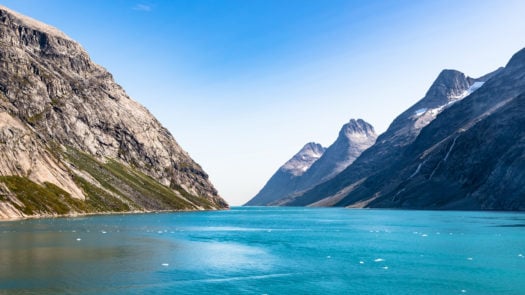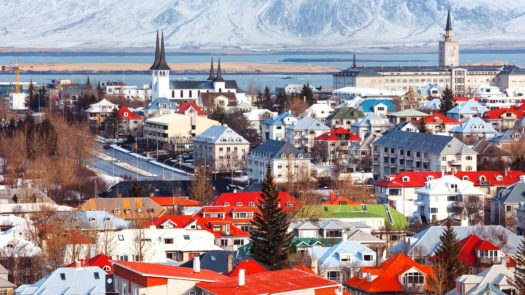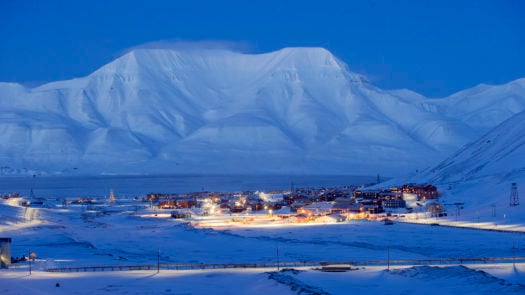As you sail through the glassy turquoise expanse of ice fjords, past calving glaciers and sculptural icebergs jutting out from the glittering ocean, you’ll find you have reached the tangible epitome of tranquility.
It is one thing to experience the dumbfounding awe of the Arctic up close, upon its rugged and frozen landscapes. Yet it is an entirely incomparable experience to glide through its waters as a silent observer, with the distance needed to appreciate the entirety of the natural spectacle before you.
However, with an Arctic cruise you need not choose, for you will be sure to experience both the passive and the active, the calm and the exhilarating. The humbling and inspiring.
Browse our range of cruising locations below for an insight into what is on offer.

Destinations
Greenland
Greenland is the perfect country to explore both by sea and on land and a true highlight on any Greenlandic arctic cruise is the Prince Christian Sound, also known as the Prins Christian Sund, which connects the Denmark Strait with Davis Strait. The Prince Christian Sound offers one of South Greenland’s most dramatic natural landscapes, contrasting to the tranquility of the calm waters below and the mesmerising flow of waterfalls on either side of you as you sail through.

As well as dramatic landscapes, Greenland is also full of colourful villages dotting the vast and unspoiled landscape, such as the small settlement of Aapilattoq. This small settlement offers insight into the traditional lives of modern Greenlandic Inuit. Hvalsey is another settlement worth exploring once on land, yet this is a settlement much left in the past: specifically the era of the vikings. Found at the end of a majestic fjord, Hvalsey is undoubtedly the best of South Greenland’s several Norse ruins scattering the land. Yet no journey to Greenland is complete without a stop in Nuuk, the country’s capital, known for its huge fjord system where you’ll see an array of waterfalls, humpback whales and icebergs.

Iceland
An arctic cruise demands a stop in the world’s most northerly capital, Reykjavik, found in Iceland. With a colourful old quarter, quaint wooden houses and streets all cradled by snow-capped mountains and volcanic surrounds, Reykjavik is a vibrant gateway city to the abundant arctic adventures this country has to offer. Reykjavik also usually marks the start of the Golden Circle; a handful of must-see attractions in the South West of the country, such as the country’s most active geyser Strokkur, Gullfoss waterfall and the idyllic Lake Thingvallavatn.

For more Icelandic natural wonders, many arctic cruises sail past the Hornbjarg Cliffs which rise to 537 metres in the northernmost part of Iceland’s Westfjords, and make up part of the Hornstrandir Nature Reserve where Atlantic Puffins, among several other incredible bird species, can be spotted. Dynjandi Waterfalls also provides another spectacular sight in the Westfjords region. This iconic waterfall, is undoubtedly Iceland’s most majestic waterfall due to its overwhelming sheer force and size. Its cascading water over 100 feet wide tumbles over 300 feet into the fjord, and is bound to take your breath away.

Svalbard
Svalbard is an unmissable staple of any arctic cruise; a Norwegian archipelago and land of the sublime where, in the summer months, the sun dances pirouettes around the bright white sky, producing 24 hours of continuous daylight. It is also home to the northernmost inhabited town in the world: Longyearbyen, also the largest settlement in Svalbard. Here you’ll find the airport, the Svalbard Museum, and intriguing remnants of the former mining activity that used to run this town. Svalbard is filled with treasures both north and south, and found in the former is the beautiful and spellbinding Monaco Glacier and Seliger Glacier as well as many walrus haul-outs and areas known as the Arctic desert.

In contrast, the south is considerably less icy, due to the warm Atlantic ocean current known as the Gulf Stream. In the south you’ll find the archipelago’s largest island of Spitsbergen where you can explore the remains of both historic huts and mines. The landscape changes dramatically according to the season and at different times in the year, glaciers in the south can be visited both on foot or by sea. Many cruises sailing from Tromsø to the south of Svalbard, stop at Bear Island to explore the impressive nature reserve known for its greenery and steep cliffs. Here you can relax in the milder environment, for despite the island’s concerning name, it is only known to be visited by a variety of harmless seabirds.









